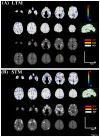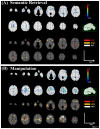Imaging-based biomarkers of cognitive performance in older adults constructed via high-dimensional pattern regression applied to MRI and PET
- PMID: 24392010
- PMCID: PMC3877379
- DOI: 10.1371/journal.pone.0085460
Imaging-based biomarkers of cognitive performance in older adults constructed via high-dimensional pattern regression applied to MRI and PET
Abstract
In this study, we used high-dimensional pattern regression methods based on structural (gray and white matter; GM and WM) and functional (positron emission tomography of regional cerebral blood flow; PET) brain data to identify cross-sectional imaging biomarkers of cognitive performance in cognitively normal older adults from the Baltimore Longitudinal Study of Aging (BLSA). We focused on specific components of executive and memory domains known to decline with aging, including manipulation, semantic retrieval, long-term memory (LTM), and short-term memory (STM). For each imaging modality, brain regions associated with each cognitive domain were generated by adaptive regional clustering. A relevance vector machine was adopted to model the nonlinear continuous relationship between brain regions and cognitive performance, with cross-validation to select the most informative brain regions (using recursive feature elimination) as imaging biomarkers and optimize model parameters. Predicted cognitive scores using our regression algorithm based on the resulting brain regions correlated well with actual performance. Also, regression models obtained using combined GM, WM, and PET imaging modalities outperformed models based on single modalities. Imaging biomarkers related to memory performance included the orbito-frontal and medial temporal cortical regions with LTM showing stronger correlation with the temporal lobe than STM. Brain regions predicting executive performance included orbito-frontal, and occipito-temporal areas. The PET modality had higher contribution to most cognitive domains except manipulation, which had higher WM contribution from the superior longitudinal fasciculus and the genu of the corpus callosum. These findings based on machine-learning methods demonstrate the importance of combining structural and functional imaging data in understanding complex cognitive mechanisms and also their potential usage as biomarkers that predict cognitive status.
Conflict of interest statement
Figures





References
-
- Albert MS, DeKosky ST, Dickson D, Dubois B, Feldman HH et al. (2011) The diagnosis of mild cognitive impairment due to Alzheimers disease: Recommendations from the National Institute on Aging and Alzheimers Association workgroup. Alzheimer'S Dementia 7: 270–279. doi:10.1016/j.jalz.2011.03.008. PubMed: 21514249. - DOI - PMC - PubMed
-
- De Rover M, Pironti VA, McCabe JA, Acosta-Cabronero J, Arana FS et al. (2011) Hippocampal dysfunction in patients with mild cognitive impairment: a functional neuroimaging study of a visuo-spatial paired associates learning task. Neuropsychologia 49: 2060–2070. doi:10.1016/j.neuropsychologia.2011.03.037. PubMed: 21477602. - DOI - PubMed
Publication types
MeSH terms
Substances
Grants and funding
LinkOut - more resources
Full Text Sources
Other Literature Sources
Medical

